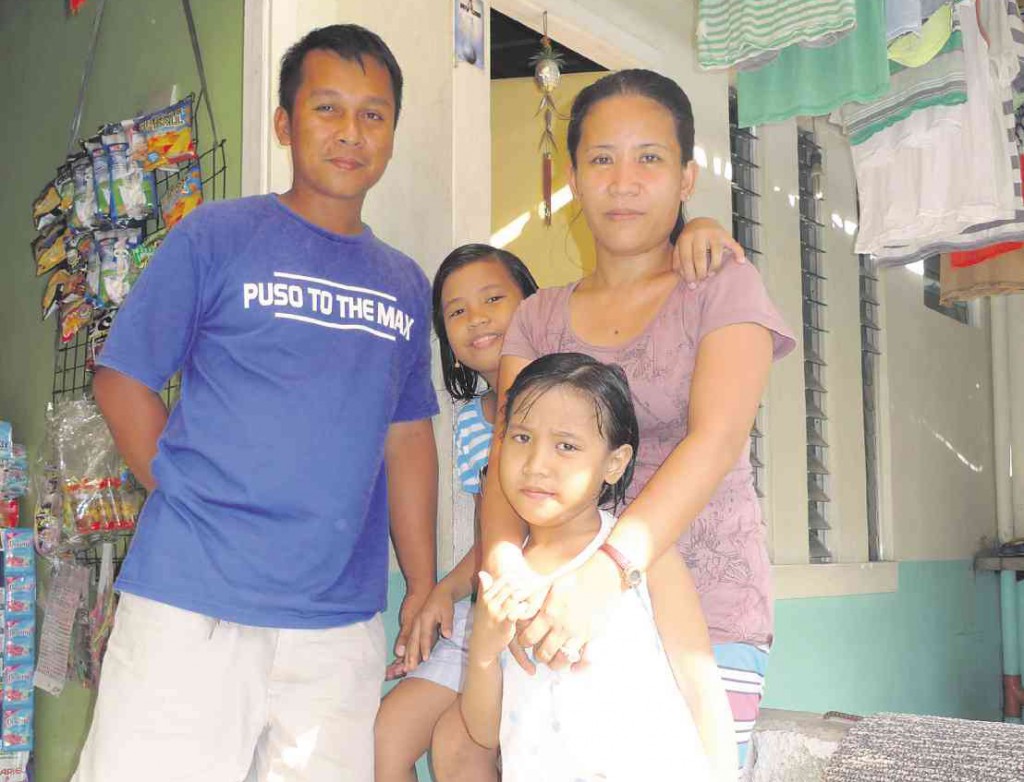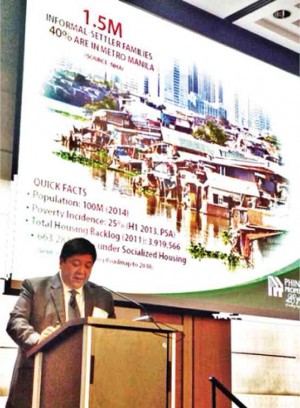From slum dwellers to role models
For years, the family of 34-year-old-housewife Lilibeth Albelda has endured the life of a slum dweller. Albelda said: “Water was scarce and expensive. Worse, the ambulant delivery trucks came irregularly; electricity was even more expensive since it was tapped via submeters. Whenever it rains, we had to carry our children until we reach the main road in order to avoid the mud and mire that was everywhere.”
She reminisced that in 2007 she moved in to this sprawling 4.7-hectare neighborhood in Barangay Kaligayahan in Novaliches, Quezon City. The community, which was then home to around 700 families, was formerly known as Sitio Looban because its location is tucked away from the main road, surrounded by various properties and accessible only via a single dirt road.
But while the community remained in the same location, it has undergone significant transformation in 2012. The dirt roads gave way to paved streets. There is now a regular supply of water and electricity. The drainage and sewerage system has also been improved. While most families remained in place, they are now housed in more decent and safer homes, which they will eventually own through Pag-Ibig financing.
“The family of Albelda and the rest of her neighbors are the type of homebuyers we have been targeting for years. Finally, we now have a blueprint on how we could effectively help these thousands of informal settlers who also desire to uplift their living condition,” said Willie Uy, president and CEO of Phinma Properties which developed Sitio Looban into what is now known as Bistekville II.
Phinma Properties was tapped by the Quezon City government to come up with a masterplanned community on the same location where slum dwellers live and quickly move them to a more dignified living space that they could afford, an issue that has been a challenge for other mass-housing projects.
Uy’s job required the human touch, as he convinced the families to vacate their old houses, then bulldoze that particular area and erect a mix of concrete lofted rowhouses as well as three-story condominium buildings that could become their homes via a monthly amortization to Pag-Ibig.
“They were transferred to an adjacent lot while they wait for their new homes to get finished, which is just a few weeks of waiting,” said Uy.
Largest in QC
When the project finally welcomed back the families in 2012, the site became the largest on-site, in-city socialized housing for Quezon City’s disadvantaged families. It also has a new name—Bistekville II.
Uy informed that by the end of this year, Phinma Properties will be able to finish all the needed 1,078 housing units—composed of 703 lofted rowhouses (with 27-square-meter total floor area) and 375 condo units (with 23-sq-m floor area)—that the Quezon City government has commissioned the company to build.
Uy explained that through the building technology—cast-in-place construction method—that Phinma pioneered in the country, they were able to simultaneously construct a line of up to eight rowhouses within 15 days, which is much shorter than the conventional construction methods (using structural frames made from concrete beams, columns and hollow blocks) that take two to three months to finish.
He added that few developers are interested in investing in socialized housing (units priced from P450,000 and below) because the margins are lower than in any other market segment. “But because of the volume and Phinma Properties’ building technology, returns to our shareholders are ‘quite attractive,” explained Uy, adding that socialized housing will account for at least 30 percent of the company’s upcoming projects, as negotiations are underway with a number of local government units for mass housing projects similar to Bistekville II.
Moreover, Uy said the company is also able to enjoy 30-percent off taxable income from profit as incentive for complying to Section 18 of Republic Act No. 7279, or the Urban Development Housing Act, which requires developers to devote an area for socialized housing equivalent to at least 20 percent of the total land area or cost of the project.
Inducted
Because of the success of this public-private partnership, Phinma Properties, as represented by Uy, was formally inducted into the distinguished Business Call to Action (BCtA) leadership platform last September in New York City.
This means the company is now a recognized global partner in making successful business initiatives that engage more sectors of society, especially low-income families. The BCtA fifth annual forum is a global initiative that seeks to harness the power of business investments to reduce extreme poverty and to improve the lives of millions.
Uy said: “Hosted by the United Nations Development Program, the BCtA challenges companies around the world to develop inclusive business models that offer the potential for both commercial success and development impact. During the meeting, I explained that in order for Bistekville II to succeed, we teamed up with the Quezon City government so we could buy the property from the landowner who had tried for three decades to evict the almost 700 families living there.”
Uy explained: “The way to respond to the problem of informal settlements here in Metro Manila is not to simply relocate them to far-flung areas, away from their source of living. What we did here was find a way not to move them, take advantage of our construction technology that allows us to complete the project at a shorter time and less cost for us. As a result, Phinma Properties was able to construct affordable and decent housing units that were sold to participating families for only P400,000, which is payable in 30 years through Pag-Ibig.”
Other partners
Also tapped as partner was the Philippine Business for Social Progress that conducted livelihood and skills training programs for the new homeowners, providing them not only with concrete shelter but also the very means to earn a decent living to pay off their homes and to meet their daily household needs. Another nongovernment organization, Focolare Movement, was also engaged for values and spiritual formation.
He added that with what the partnership did with Bistekville II, a better long-term solution to informal settlement problem was conceived: To integrate these families in the urban landscape with provision for clean water and livelihood, as well as a safe environment.
“We were given the option to be relocated but, as I discussed this with my husband Lucilo, this could mean additional transportation cost for him who works as a salesman here in Quezon City and Valenzuela City. Moving out also means transferring our three kids to another school,” said Albelda who also maintains a small sari-sari (variety) store and makes kutsinta to help his husband meet the P2,246 monthly amortization and other expenses.
She added that at least her family no longer has to depend on some shady groups that demand exorbitant fees for basic services such as water and electricity.
Uy explained: “The rise in the number of poor people moving to urban areas of Metro Manila means it will be many years before the shacks of slums can be cleared away and replaced with concrete and safer homes. The number of families in informal settlements in Metro Manila has already reached over 500,000, 40 percent of which, or over 200,000 families, are located in Quezon City. For a company like us, this could be a potential market.”
He added that on-site development should prove more effective because families would not be displaced from their place of work, and their children from their school and friends. For old neighbors, the camaraderie earned would remain intact.


